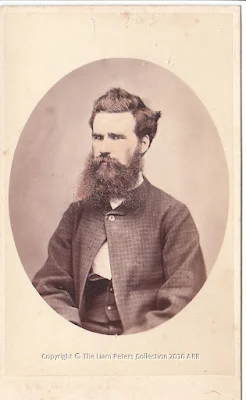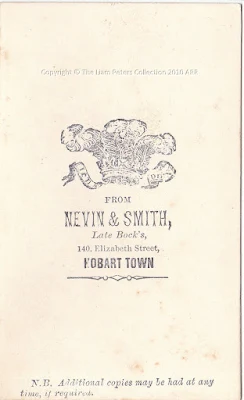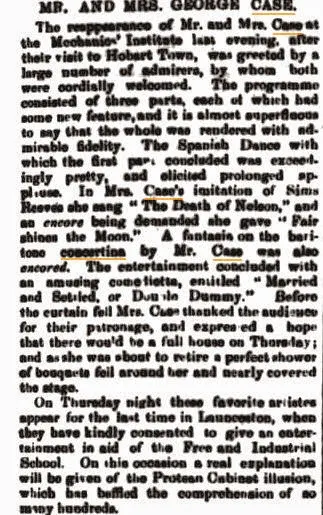Robert Smith may have operated a studio in Hobart prior to his partnership with Nevin, as Mrs Esther Mather referred briefly to the "coloured ones from Smith's" in a letter to her step-son, dated October 1865. On Robert Smith's departure in January 1868 to Goulburn, NSW where he set up a studio, Thomas Nevin used their label on the verso of a few more photographs, but with Smith's name struck through, the word "Late" added, and the plural signifier "s" of "photographers" crossed out.
Studio portraits
Two studio stamps and one label have survived from their brief partnership. The first stamp featuring the Prince of Wales' blazon of three feathers and a coronet, banded with the German "ICH DIEN" (I Serve) dates from the visit of Alfred Ernest Albert, the Duke of Edinburgh, second son of Queen Victoria in late 1867 on his first command, the royal yacht H.M.S. Galatea.
This carte-de-visite photograph on a plain mount of two unidentified children may have been intended for inclusion in an album of photographic prints depicting the children of Tasmania which was gifted to Prince Alfred during his visit to Hobart before he returned to Sydney in January 1868 where he was to survive an assassination attempt weeks later (Clontarf, March 1868).
Title: [Studio portrait of two children] [picture] / Nevin & Smith.
Access/Copyright: Reproduction rights: State Library of Victoria
Accession number(s): H2005.34/2004. H2005.34/2004A


Cdv of bearded young man in check jacket
Cdv in oval mount, hand-tinted, studio stamp verso.
Photographers: Nevin & Smith, Hobart, 1868
Copyright © KLW NFC Imprint & courtesy of the Liam Peters Collection 2010
This photograph, a delicately coloured carte-de-visite portrait of an unidentified young man with wispy beard man in semi-profile, wearing a summer check-patterned jacket, which is printed verso with the rare Nevin & Smith stamp featuring the Prince of Wales' three feathers insignia, was also taken in late 1867 during Prince Alfred's visit to Hobart.
Thomas Nevin photographed his future wife Elizabeth Rachel Day (1847-1914) during the summer of 1867-1868; they married in July 1871 at the Wesleyan Chapel, Kangaroo Valley (Tasmania). He took this photograph of his fiancée when she was barely out of her teens, circa 1867, while operating the studio at 140 Elizabeth St. Hobart under the name of Nevin & Smith. Although a personal memento in many respects, and as such, surprisingly stamped verso, it may have been intended for sale to a large circle of friends, such as the group featured in the stereograph below which was probably one of three taken during an excursion to the Shoobridge hop fields at Valleyfield, New Norfolk, on 27th December, 1867. Or perhaps it was taken of another group of Terpsichoreans who celebrated Queen Victoria's birthday on May 27th, 1868 at Rosny.
Elizabeth Rachel Day, married Thomas Nevin in 1871
Taken by Thomas Nevin at Nevin & Smith (late Bock's) ca. 1867-8
140, Elizabeth Street Hobart Town
Full-length portrait, carte-de-visite
Copyright © KLW NFC Imprint & Private Collection. Watermarked.
Terpsichoreans
Just possibly, the stereograph below of a large group of men and women in formal wear, some seated on the grass, many more dancing in a circle close to the River Derwent, was taken about the same time as the full-length portrait of Elizabeth Rachel Day. She wore a white dress and dark topcoat, her white hat placed on top of a photo album for the studio portrait, and many women in this outdoor stereograph wore the same outfit on this day of festivities. Dozens of men wore a striking white hat with a wide brim, floppy crown and black band visible in other photographs by Nevin. In all likelihood, this stereograph bearing the Nevin & Smith pink label verso without amendments to the business name was one of three photographs Thomas Nevin was reported to have taken during the excursion to Shoobridge's estate on 27th December, 1867, sponsored by the Working Men's Club, viz:
Source: Tasmanian Times (Hobart Town, Tas. : 1867 - 1870), Saturday 28 December 1867, page 3
TRANSCRIPT
WORKING MEN'S CLUB EXCURSION TO NEW NORFOLKSource: Tasmanian Times (Hobart Town, Tas. : 1867 - 1870), Saturday 28 December 1867, page 3
Yesterday the steamer Monarch, specially chartered by the Working Men's Club, conveyed between 300 and 400 excursionists to New Norfolk. This was the order of the day. An excellent brass band performed a variety of dance music on the bridge, and a number of indefatigable votaries of Terpsichore tripped it away "on the light fantastic toe" throughout the whole of the upward voyage. New Norfolk was reached by about ½ past 12. The majority of the excursionists proceeded at once to Valleyfield, the beautiful seat of Mr. Shoobridge, who kindly threw open his grounds to the visitors, and supplied all and sundry with hot new potatoes and green peas fruit and tea. Pic-nic parties were soon formed in all directions under the trees, and everybody seemed thoroughly to enjoy Mr. Shoobridge's genial hospitality. After refreshment the band summoned the company to the hop-room, where dancing was kept up for nearly a couple of hours. After this football, foot races, kiss in the ring etc. occupied the young folks for some time in a large paddock near the house, during which Mr. Nevins [sic] took three photographic views of the animated scene. We regret to state that an accident which might have proved serious, occurred during the day. In descending the wooden steps leading to the hop-room, a lady missed her footing and fell to the ground, some 12 or 15 feet, on her head, receiving several cuts and contusions on the face. The sufferer received every possible attention from Mrs. Shoobridge, and mainly owing, under Providence, to that excellent lady's assistance and succour was enabled to return to town by the steamer. On the homeward voyage, the excursionists were overtaken above Bridgewater by a violent squall of wind and rain, which damped for a time the ardour of their enjoyment. But as soon as the rain ceased, dancing was resumed once more, and "all went merry as a marriage peal." Mr. Henry Dobson, the secretary of the Working Men's Club, was unremitting in his exertions to promote the harmony and hilarity of the excursion; and with the drawbacks just mentioned, the whole trip was a very enjoyable success.
Possibly it was the same group of Terpsichoreans who danced at Rosny at one of the many events celebrating the 49th birthday of Queen Victoria on 28th May 1868:
TRANSCRIPT
CELEBRATION OF HER MAJESTY'S BIRTHDAY.The Mercury report continued with a paragraph about a dancing party at Rosny, and a spot of bother:
Yesterday being declared a general holiday by proclamation, to celebrate the 49th anniversary of the birth of Her Most Gracious Majesty Queen Victoria, was very closely observed as such throughout the city. The stores, merchants' offices, and shops were all closed, with the exception of a few of those devoted to the sale of creature comforts, and the people very generally betook themselves to scenes of enjoyment. There were many private pic-nic and excursion parties, and a long list of public amusements was provided. Soon after sunrise the flagstaff on Mulgrave Battery was dressed with appropriate colors, the " flag that braved a thousand years" waving proudly over all. At the Battery Staff, and also at the Telegraph Office, the Royal Standard was hoisted, and at the offices of the several consuls the flags of various nations were displayed. The shipping in harbor likewise made a good display of bunting, and at many of the shops and residences in the city staffs, which had been erected to do honor to " the Duke," bore national ensigns in honor of his Queen mother....
TRANSCRIPT
ROSNY.Source: CELEBRATION OF HEB MAJESTY'S BIRTHDAY. (1868, May 28). The Mercury (Hobart, Tas. : 1860 - 1954), p. 2. http://nla.gov.au/nla.news-article8852443
A number of people yesterday took advantage of the holiday to pass a few hours at Rosny, where arrangements had been made for their amusement. A race between two skiffs, for £4 a side, took place, and appeared to be watched with considerable interest by the spectators. A brass band which had been engaged discoursed sweet music, to which the Terpsichoreans danced incessantly until about 5 o'clock, when the steamer made her last trip to Hobart Town. A very pleasant afternoon was spent, the only interruption to the general harmony being caused by the conduct of several young "roughs," who terminated their disgraceful proceedings by a general fight on board the boat.


Stereograph by Nevin & Smith of Terpsichoreans at New Norfolk, 27 December 1867 or Rosny, 27th May 1868
Verso label: "Tasmanian Views from Nevin & Smith Photographers"
Photos recto and verso copyright © KLW NFC Imprint 2014-2015
Taken at the Tasmanian Museum and Art Gallery, 10 November 2014
TMAG Ref: Q1994.56.20.1
Tasmanian Museum and Art Gallery Collection (online catalogue 2006)
"Tasmanian Views from Nevin & Smith .... plus Tombstones copied, Terms - Cheap!"
REF: Q1994.56.20.1
ITEM NAME: Label:
MEDIUM: Paper and printing ink,
MAKER: Nevin & Smith [Artist];
DATE: 1860s
DESCRIPTION : Label from the back of Q1994.56.20 for photographers Nevin & Smith, 140 Elizabeth Street, Hobarton
INSCRIPTIONS & MARKS: On back a pink label: Tasmanian views/ from/ Nevin & Smith,/ Photographers,/ 140, Elizabeth St., Hobarton./ Stereoscopic and Album Portraits/ Views Photographed./ Viiews of Residences, Tombstones copied, Terms —Cheap!
Residences
This stereograph of a house bears a yellow rather than pink Nevin & Smith label, with Smith's name struck through, the word "Late" superimposed, and the plural "s" on the word "Photographers" crossed out. It was taken before Robert Smith's departure from the partnership in January 1868 but reprinted soon after. From 1869, Nevin replaced this label with a blind stamp impress on the recto of outdoor stereographs with the simple wording "T. Nevin Photo". Different extant stamps, labels and verso inscriptions used by Nevin to date number at least eight.
Unlike the single image carte-de-visite photograph (below) of a large single-storey house on a hill taken by Nevin of his parents' family home at Kangaroo Valley in 1868, this stereograph of a house bears his commercial label (Smith's name struck through) pasted verso, and was therefore intended for sale to clients. The subject of the photograph represents one of several houses built to a similar architectural template in the Kangaroo Valley area. Some tinting of the grass in this image was attempted but otherwise abandoned, suggesting a rejected copy.


Stereograph by Nevin & Smith of four people outside a house with side extensions
Verso: Nevin & Smith yellow label ca. 1868
Photos recto and verso copyright © KLW NFC Imprint 2014-2015
Taken at the Tasmanian Museum and Art Gallery, 10 November 2014
TMAG Ref: Q16826.9
Tasmanian Museum and Art Gallery Collection (online catalogue 2006)
REF: Q16826.9
ITEM NAME: photograph:
MEDIUM: albumen silver print sepia toned stereoscope,
MAKER: T Nevin [Photographer];
TITLE: 'Tasmanian Views.'
DATE: 1870c
DESCRIPTION : No information relative to title of his images. This one, of a house or maybe a school.
INSCRIPTIONS & MARKS: (On bacK) Tas. Views from Nevin & Smith (Late) Photographers (s crossed out) 140 Elizabeth Street. Steroscopic and Album Portraits Views Photographed. Views of Residences, Tombstones copied, Terms:-Cheap!

The cottage that John Nevin built at Kangaroo Valley Tasmania
"T.J. Nevin Photo" inscribed on verso, ca. 1868. Exhibited at Wellington Park 1868.
From © KLW NFC Imprint & The Liam Peters Collection 2010.

Dissolution of partnership Robert Smith and Thomas Nevin
Mercury 26 Feb 1868
This dissolution notice was published in the Mercury on 26 February 1868 of the partnership between Robert Smith and Thomas Nevin. William Robert Giblin, later Attorney-General and Premier, was Thomas Nevin's solicitor and witness. Robert Smith moved to Goulburn, NSW where he opened a studio.
The Tasmanian Museum and Art Gallery holds fifty or more of stereographs by Thomas J. Nevin, some stamped verso, some inscribed verso and some blank, in addition to the fifty of so photographs of prisoners ("convicts") taken by T. J. Nevin in the 1870s. Many of the stereographs have survived in barely fair condition, not simply because these early stereos were printed on absorbent salt paper which rendered the image fuzzy over time, they were salvaged from private and public archive locations where conditions were less than optimal. Wherever two very similar photographs have survived, one with Nevin's stamp or inscription, one without, the following circumstances of their production have to be considered:
1. duplicates of a stamped original chosen for commercial profit were not routinely stamped but simply supplied to the client as a copy.
2. duplicates of an original or another very similar original showing the same subject and location but differing in minor details of pose etc were not stamped, especially photographs taken for immediate use by friends, family or even government officials well -known to the photographer.
3. one original photograph bearing a specimen studio stamp was submitted to the Customs and Patent Office to register copyright of that particular stamp for one year, or for a limited quantity to be produced for a specified fee. Nevin covered the registration of eight different studio stampdesigns and imprints from 1865 to 1888.
4. some originals were flawed at the moment of capture, or rendered useless during printing and colouring, and so not stamped or circulated but nonetheless retained by the studio, which then ensured a life beyond the photographer's control in the hands of collectors.
5. many stock commercial negatives by Nevin were acquired and reproduced by Samuel Clifford until Clifford's retirement in 1878. The Anson Brothers acquired Nevin's, Clifford's and even Baily's negatives (the latter through Joshua Anson's theft) and reproduced them with their own studio stamps.
Despite these caveats which segue into disputes about attribution, it must be remembered that Thomas Nevin began professional photography around 1863 at New Town, then ca 1865 with Alfred Bock, continued as a partner in commercial production with Robert Smith, Samuel Clifford and Henry Hall Baily, as well as taking commissions as a government contractor for the Colonial Government's Lands Department, the Hobart City Corporation, the Municipal Police Office, and the New Town Territorial Police, retiring from professional photography after twenty-five years only at the birth of his last child, Albert, in 1888. To date, 450 or so photographs have been identified and attributed correctly as the work of Thomas J. Nevin (1842-1923); many more sit in archives and private collections yet to be aired and taken for a stroll down the virtual highway.
The ANSON Bros' Books of Tasmanian Scenes

Title: Anson's books of Tasmanian scenes, both north, south and the interior
Creator(s):Anson Bros
Date: 1890?
Description: 1 endpaper : Black/red lettering, 40 X 58 cm.
Related to: In: Picturesque and interesting Tasmania. No. 1
Subjects: Anson Bros. Craw and Ratcliff, Booksellers, Stationers and Fancy
Other titles: Best photographs of Tasmania's world-fames scenery, mountains, lakes, ferns and rocks Endpaper of album
Format: album
Location: Tasmaniana Library
ADRI: AUTAS001125641373
John Anson acquired the stock in 1878 of both Thomas Nevin and Samuel Clifford; he reprinted - on glass - an Aboriginal portrait originally taken by Charles A. Woolley in 1866 which is privately held in the McCullagh Collection. With his brother Joshua, recently released from prison, the Anson Bros reproduced Clifford and Nevin's photographs taken in 1873 and 1874 at Port Arthur, which they then printed as an album and sold in 1889 with the title Port Arthur Past and Present, .held at the SLNSW
Anson Bros. photographic album, Port Arthur Past and Present (1889), held in the SLNSW.
State Library of NSW
Photos copyright © KLW NFC 2009
RELATED POSTS main weblog
- Tasmanian Museum and Art Gallery databases
- Six of Nevin’s salt paper stereos at TMAG
- Nevin and Smith stereo of Elizabeth St studio
- Thomas Nevin and the Terspsichoreans, New Norfolk 1867
















